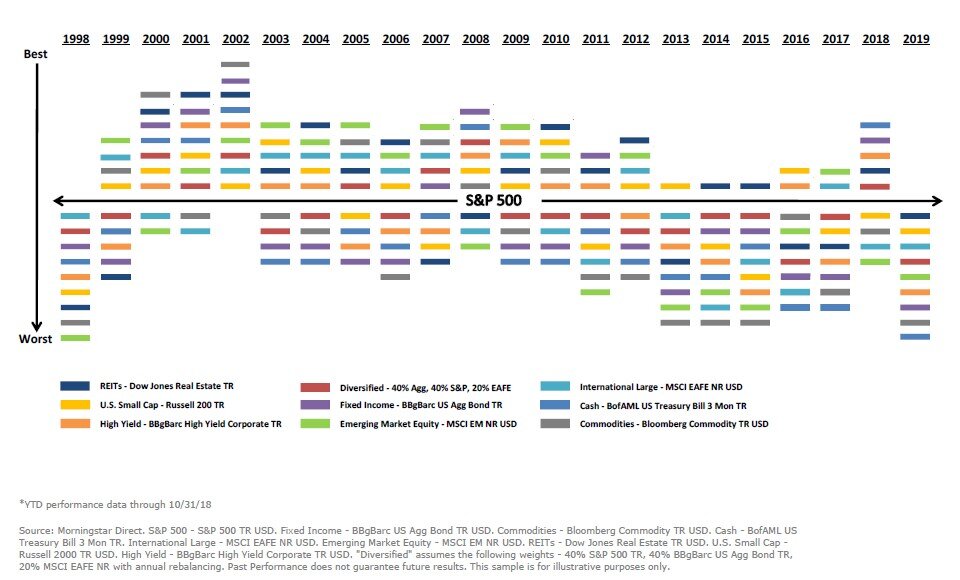It’s historically proven, the age-old advice urging you to stick with your investment plan through thick and thin. The Center preaches this, especially during market volatility. But maybe your financial advisor has recently suggested making a change in your investment plan. How could this be? Well, there are two possible reasons: either your circumstances changed or new information emerged about the market.
1. Your circumstances changed
Retiring in 2020 or the near future? Wow, what a way to end your career, and congratulations! There may be a case to make your portfolio more conservative so that when volatility hits, you see less downturn than you might in a more aggressive model. Read this if you’re concerned about your 401k balance fluctuation.
Big purchase ahead? Sticking with your investment plan is a long-term view. When you’ve set your sights on a making a big purchase soon, consider taking a portion of your portfolio to cash or a short-term fixed income fund.
Your paycheck comes from your portfolio? Consider taking the next six months of expenses in cash or a short-term fixed-income fund so that when you hear market news, you can sleep soundly knowing your next portfolio paycheck will not be affected.
None of these apply but you’re unsure about your portfolio allocation? Read this.
2. New information about the market
As interest rates fell in March, we saw a short-term opportunity to tactically overweight the Strategic Income portion of the Fixed Income category in some portfolio models. Generally, Strategic Income funds invest in high-yield bonds, emerging market debt, international bonds, asset, and mortgage-backed securities. This short term strategy was sought out by our Investment Committee as we aim to add value to our clients’ portfolios during market volatility. We closely tracked the Bank of America US High Yield Index Option-Adjusted Spread and set a point where we would tactically switch the allocation back to short and long term fixed income funds. Here’s one of the charts we watched:
Ice Data Indices, LLC, ICE BofA US High Yield Index Option-Adjusted Spread [BAMLH0A0HYM2], retrieved from FRED, Federal Reserve Bank of St. Louis; https://fred.stlouisfed.org/series/BAMLH0A0HYM2, August 28, 2020.
The Investment Committee saw an opportunity in the gold market. Gold is primarily seen as a hedge against inflation risk within the US Market. As the Federal Reserve printed cash at a rapid pace in April 2020, the value of the US Dollar slipped and many investors flocked to gold as a hedging measure. Gold can also be seen as a consistent store of value during a choppy period of high unemployment and low business activity; its long-term value has steadily increased.
The fiduciary standard of seeking return while managing risk is our priority. A strong investment portfolio compliments a clear financial plan. As your circumstances change and the market gives us more information, we are committed to your personal financial goals within the financial planning process. As always, please contact your Center Financial Planner for advice on your specific situation.
Abigail Fischer is an Investment Research Associate and Investment Representative at Center for Financial Planning, Inc.® She gained invaluable knowledge as a Client Service Associate, giving her an edge as she transitions into her new role in the Investment Department.
This market commentary is provided for information purposes only and is not a complete description of the securities, markets, or developments referred to in this material. Any opinions are those of the author and not necessarily those of Raymond James. There is no guarantee that these statements, opinions or forecasts provided herein will prove to be correct. Investing involves risk and you may incur a profit or loss regardless of strategy selected. Past performance does not guarantee future results. Diversification and asset allocation do not ensure a profit or protect against a loss. Investing in commodities is generally considered speculative because of the significant potential for investment loss. Their markets are likely to be volatile and there may be sharp price fluctuations even during periods when prices overall are rising. Gold is subject to the special risks associated with investing in precious metals, including but not limited to: price may be subject to wide fluctuation; the market is relatively limited; the sources are concentrated in countries that have the potential for instability; and the market is unregulated.




![Ice Data Indices, LLC, ICE BofA US High Yield Index Option-Adjusted Spread [BAMLH0A0HYM2], retrieved from FRED, Federal Reserve Bank of St. Louis; https://fred.stlouisfed.org/series/BAMLH0A0HYM2, August 28, 2020.](https://images.squarespace-cdn.com/content/v1/54341a03e4b08690c01bc8de/1599151169950-8HUBLRL93UWPKOW56JKT/Center+for+Financial+Planning%2C+Inc.+Retirement+Planning)



























